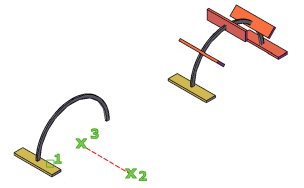Creates nonassociative, 3D rectangular or polar arrays.
3DARRAY functionality has been replaced with the enhanced ARRAY command, which allows you to create associative or nonassociative, 2D or 3D, rectangular, path, or polar arrays. 3DARRAY maintains legacy behavior.
For 3D rectangular arrays, in addition to columns and rows, you also specify the number of levels in the Z direction. For 3D polar arrays, you specify the axis of rotation with any two points in space.

The entire selection set is treated as a single element in the array.
The following prompts are displayed.
Select objects
Select the objects to array.
Rectangular
Copies objects in a matrix of rows (X axis), columns (Y axis), and levels (Z axis). An array must have at least two rows or two columns or two levels.


Positive values generate the array along the positive X, Y, and Z axes. Negative values generate the array along the negative X, Y, and Z axes.
- Number of rows (---)
- Specifies the number of rows to repeat along the X axis.
- Number of columns (|||)
- Specifies the number of rows to repeat along the Y axis.
- Number of levels (...)
- Specifies the number of rows to repeat along the Z axis.
- Distance between rows (---)
- Specifies the distance between the base points of the items arrayed along the X axis.
- Distance between columns (|||)
- Specifies the distance between the base points of the items arrayed along the Y axis.
- Distance between levels (...)
- Specifies the distance between the base points of the items arrayed along the Z axis
Polar
Copies objects about an axis of rotation. The specified angle determines how far the objects are arrayed about the axis of rotation.

- Number of items in the array
- Specifies the number of arrayed items.
- Angle to fill
-
Specifies the angle between the first and last item in the array. A negative number produces a clockwise array rotation.
- Rotate arrayed objects?
- Controls whether items are rotated as they are arrayed.
- Yes. Rotates the items along the axis of rotation.
- No. Retains the same orientation for all objects in the array.
- Center point of array
- Specifies the center point of the arrayed objects.
- Second point on axis of rotation
- Specifies a second point that sets the direction of the axis of rotation from the center point.